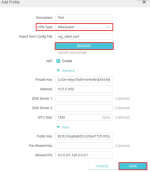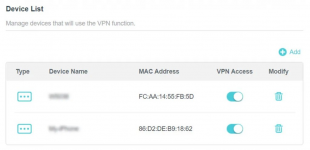Fixxx
Moderator
- Joined
- Aug 21, 2024
- Messages
- 670
- Reaction score
- 3,328
- Points
- 93
Before starting the settings, let's clarify why a VPN is needed at the router level. A router provides protection for all devices on the network.
Instead of setting up a VPN on each device individually, you can configure a VPN on the router - ensuring the security of the entire network.
Before we move on to configuring, let's look at which other VPN protocols are supported by TP-Link routers. Each protocol has its advantages:
First, you need to log into the router's web interface. Open a browser and enter the address: http://tplinkwifi.net. If that address doesn't work, try 192.168.0.1 or 192.168.1.1. Additionally, if any VPN client is already active on your device, it must be turned off. Enter your username and password. If you’ve forgotten them, check the sticker on the router for the factory credentials.
Navigate to the Advanced > VPN Client section. Enable the VPN client and click Save. Click Add to create a new connection. In the VPN Type field, select WireGuard.
Next, upload the configuration file from your VPN provider by clicking Browse.
Enable WireGuard in the list of servers. After activation, select which devices will use the VPN.
If the VPN doesn't work, there may be extra lines in the configuration file. Remove them and try uploading the file again.
Now your TP-Link router not only provides internet access but also ensures your digital security. With VPN setup, you gain an additional layer of data protection. Using a VPN is an effective tool for enhancing online privacy and security. It protects your data when working on public Wi-Fi networks, provides an extra level of encryption during online banking and shopping and improves overall cybersecurity. Experiment with different VPN protocols and choose the one that best suits your device.
Setting up a VPN on your TP-Link router is an important step toward improving your privacy. Online security is an ongoing process. Continue learning and enhancing your skills. In the world of digital technology, the best protection is a combination of the right tools and knowledge. By staying informed and proactive, you can significantly enhance your online safety. Remember that the digital landscape is constantly evolving and so are the threats that come with it. Regularly updating your skills and tools will help you stay one step ahead of potential risks.
Instead of setting up a VPN on each device individually, you can configure a VPN on the router - ensuring the security of the entire network.
VPN Protocols on TP-Link Routers
Before we move on to configuring, let's look at which other VPN protocols are supported by TP-Link routers. Each protocol has its advantages:
- WireGuard - new and rapidly growing protocol with simple setup.
- OpenVPN - a time-tested and reliable option.
- L2TP/IPsec - a stable protocol with good compatibility.
- PPTP - outdated protocol still supported on many devices.
Setting Up VPN: Step-by-Step Guide
Step 1: Accessing the Router's Web Panel
First, you need to log into the router's web interface. Open a browser and enter the address: http://tplinkwifi.net. If that address doesn't work, try 192.168.0.1 or 192.168.1.1. Additionally, if any VPN client is already active on your device, it must be turned off. Enter your username and password. If you’ve forgotten them, check the sticker on the router for the factory credentials.
Step 2: Configuring VPN
Navigate to the Advanced > VPN Client section. Enable the VPN client and click Save. Click Add to create a new connection. In the VPN Type field, select WireGuard.
Next, upload the configuration file from your VPN provider by clicking Browse.
Step 3: Activating the VPN Connection
Enable WireGuard in the list of servers. After activation, select which devices will use the VPN.
Possible Nuances
If the VPN doesn't work, there may be extra lines in the configuration file. Remove them and try uploading the file again.
Additional Tips
- Firmware Update: Before setting up the VPN, ensure your TP-Link is updated to the latest firmware version.
- Protocol Support Check: Make sure your model supports the protocol you need. Not every TP-Link router allows for the same WireGuard setup.
- DNS Configuration: For greater privacy, manually set DNS servers, such as Google (8.8.8.8, 8.8.4.4) or Cloudflare (1.1.1.1, 1.0.0.1).
- Speed Monitoring: A VPN may slow down your connection. If this happens, try changing the server or protocol.
- Split Tunneling: Some TP-Link models support split tunneling, allowing you to choose which traffic goes through the VPN.
- Backup: Before making any changes, back up your router's configuration.
Conclusion
Now your TP-Link router not only provides internet access but also ensures your digital security. With VPN setup, you gain an additional layer of data protection. Using a VPN is an effective tool for enhancing online privacy and security. It protects your data when working on public Wi-Fi networks, provides an extra level of encryption during online banking and shopping and improves overall cybersecurity. Experiment with different VPN protocols and choose the one that best suits your device.
Tips for Optimization and Maintaining Security
- Regular Updates: Check for firmware updates for your TP-Link router.
- Performance Monitoring: Keep an eye on your internet connection speed after setting up the VPN.
- Password Security: Change the default passwords for router and Wi-Fi access.
- Two-Factor Authentication: Enable 2FA if supported by your router.
- Regular Checks: Review the list of connected devices on your network and change the Wi-Fi password if necessary.
Final Thoughts
Setting up a VPN on your TP-Link router is an important step toward improving your privacy. Online security is an ongoing process. Continue learning and enhancing your skills. In the world of digital technology, the best protection is a combination of the right tools and knowledge. By staying informed and proactive, you can significantly enhance your online safety. Remember that the digital landscape is constantly evolving and so are the threats that come with it. Regularly updating your skills and tools will help you stay one step ahead of potential risks.




